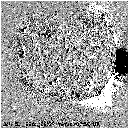
In the science nugget for July 25, we reported on a "global manifestation" resulting from a CME. This nugget presents some additional comments about the event causing it, which was truly extraordinary as viewed by SXT. The parent of the event was the "last best activity complex" of the past solar cycle, the result of many papers partly because of its isolated nature. When it was about two days beyond the W limb, some three months after its major eruption (X-classs flare and photospheric wave disturbance), it again launched a CME. The images from the science nugget for July 25 show this CME, along with the extraordinarily well-defined dimming region resulting in the SXT images. We show below a bit more of the eruption itself (negative images):

This set of four images of the W limb shows us a highly organized set of fine loop-like structures, mostly to the south of the dimming region described in the earlier nugget:

This is consistent with the idea that a large-scale ejection may move essentially horizontally, at least at the outset; below the dimming region one sees a fine example of a "spine" feature, as described by Kano (in Y. Uchida et al., eds., X--ray Solar Physics from Yohkoh (Universal Academy Press, Tokyo)). I would identify this with a heating process in a filament. In this case the filament already has risen to a great height - say some 50,000 km or more - because of the source longitude, and in fact the CME image shown in the earlier nugget did not show an obvious filament. This suggests that it had heated beyond H-alpha temperatures.
Watari et al. 1996 (.ps.gz file) describe this event in some detail and comment on the apparent lack of reconnection between the spine and arcade loops. The arcade appears to be dragged outwards while impeding the radial expansion. Is this evidence that loop-loop interactions do not always occur, even if there is a substantial antiparallel field orientation?
Oct. 31, 1998: H. S. Hudson (email hudson@isass0.solar.isas.ac.jp)